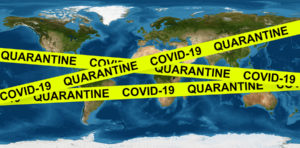

Another proposed public-private partnership reinsurance program is being talked about to cover pandemic-related business interruptions, the leader of a reinsurance association said on June 2. The proposal is in addition to three previously reported by Carrier Management.
Speaking during the Casualty Actuarial Society’s Seminar on Reinsurance, Franklin Nutter, president of the Reinsurance Association of America, gave details of the “Pandemic Reinsurance Corporation.” Nutter said that this alternative proposal is one that’s “been around for some time” but that unlike the much-discussed Pandemic Risk Insurance Act, it has not been formally introduced in any draft legislation by federal lawmakers.

PRIA, modeled after the Terrorism Risk Insurance Act, was officially introduced by Rep. Carolyn Maloney, D-N.Y. recently (as H.R. 7011). While the alternative Pandemic Reinsurance Corporation proposal is like PRIA and TRIA in that the insurance industry would bear some losses with a federal backstop reinsuring a portion of the industry losses, Nutter explained that the Pandemic Reinsurance Corporation proposal would cover small businesses with a parametric product while large businesses would get a traditional indemnity cover.
Related article: Chubb Unveils Public-Private Program for Pandemic Biz Interruption
According to Nutter, the split would be based on employee count. For small businesses with fewer than 500 employees, “the industry, while it would have some risk-bearing role in all this, would not have a traditional business interruption character to it, and therefore would not be adjusted on that basis. In fact, it would be a parametric product.”
He continued: “The same proposal looks at large businesses with 500 or more employees somewhat differently and provides an indemnity-type program. Again, the federal government [would be] providing reinsurance to any insurance companies” offering coverage.
“The interesting part of this proposal is that it not only has the industry having a risk-bearing role but that it tiers the risk-bearing role,” he said, noting that for the small business tier, the industry exposure would be roughly 6 percent commercial lines premiums up to $15 billion. For larger businesses, it would have up to 5 percent for the first five years of the program, and that would increase over time to another $15 billion, he said.
According to Nutter, under this proposal, small businesses would be required to take this coverage through workers compensation or business owners policies. At the large business level, in contrast, both the industry offer and the purchase of coverage by the businesses would be voluntary.
Asked by Carrier Management to disclose the groups or lawmakers behind the “Pandemic Reinsurance Corporation” proposal, as well as access to a copy of the proposal to review, Nutter reiterated that “no member of Congress has introduced the Pandemic Reinsurance Corporation” proposal, stating that PRIA is the only existing draft bill for a public-private partnership for pandemic-related business losses.
“I referenced all of [the proposals] because they are being circulated for a dialogue among the advocacy groups in the U.S. There is no document except by the proponents,” Nutter said.
“It is being advanced, being considered. It has not been introduced by way of legislation.”
During the session, Nutter also contrasted PRIA, in which the industry would take a risk-bearing role with a federal reinsurance backstop, with the Business Continuity Protection Program (BCPP) unveiled by the American Property Casualty Insurance Association, the National Association of Mutual Insurance Companies and the Independent Insurance Agents & Brokers of America. “The two largest industry primary [carrier] advocacy groups have advanced a proposal that essentially would have the government taking on all of this risk,” he said, referring to the BCPP. He noted that while some draw an analogy between the BCPP and the National Flood Insurance Program, the BCPP idea “is actually based on a program that was adopted after World War II by the government [when] the government took on insurance risk to help businesses in recovery mode.”

The BCPP proposal “doesn’t distinguish between large and small businesses, but it’s recovery eligibility is based upon size of companies, so there’s a diminishing recovery for the larger businesses,” Nutter said. “Again, [it’s] a parametric product, so you would not have the traditional indemnity-type of resolution by the industry,” he said. “It would be a voluntary offer by insurers. It would be a voluntary take-up by businesses.” Like other plans being discussed, the government’s exposure would be pre-funded, he added.
Nutter also mentioned the idea of a pandemic reinsurance program patterned after Pool Re in the UK. “This proposal would essentially have the industry retaining 5 percent of a risk-bearing role. It would be a parametric trigger again, not a traditional indemnity kind of product. And the government would take on 95 percent of the risk, he said. “It would be mandatory for smaller businesses and voluntary for large businesses, [and] the government’s exposure would be funded,” he said.
The Marsh Approach
Separately, before the CAS session, Marsh published a new report making its case for a public-private pandemic risk solution. In the report, “Pandemic Risk Protection: Accelerate Recovery and Build Resilience Now Through Public-Private Partnership,” Marsh notes that a range of existing public-private risk-pooling models can be used to create a solution, describing the TRIA and Pool Re frameworks. “However, the U.S. government is the only entity with the financial resources to help close the pandemic coverage gap,” Marsh said in a media statement about the report.
“We believe a pandemic risk solution is needed now to accelerate our economic recovery from the global COVID-19 pandemic and provide much-needed protection against future pandemic risks,” said John Doyle, president and CEO, Marsh, in the statement. “Our goal is to bring all stakeholders together and create the right economic incentives so insurance can serve its traditional function of mitigating risk,” he added.
Over time, Marsh said, the right public-private risk program can spur new technologies, ways of working, services, insurance products and processes to ultimately chip away at the enormous losses associated with pandemics. That, in turn, can help make pandemic risk more manageable and enable the economy to build the necessary resilience it needs for the future.
Outside the PRIA, BCPP, Pandemic Reinsurance Corporation and Pool Re-type solutions to the problem of covering businesses for income losses sustained during pandemic-related shutdowns, a business coalition known as the Business Interruption Group advanced a fifth solution last month during a House Small Business committee virtual forum. Specifically, BIG Co-Founder John Houghtaling, a Louisiana attorney, proposed a federal subsidy program that insurers would be opt into, agreeing to pay claims under all policies with business interruption coverage. They would be being reimbursed for payments they made under those policies that contained virus exclusions.
[inline-ad-1]